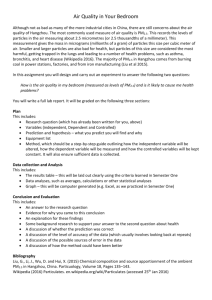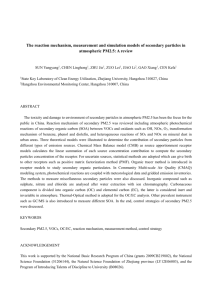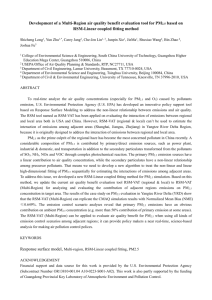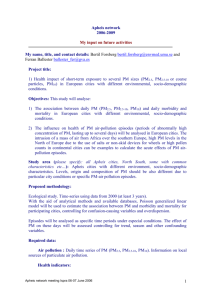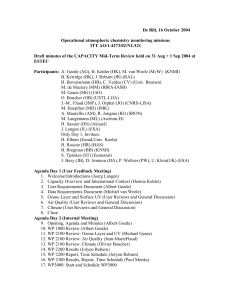Scientific Analysis of Limb-sounding Obervations of the Upper
advertisement
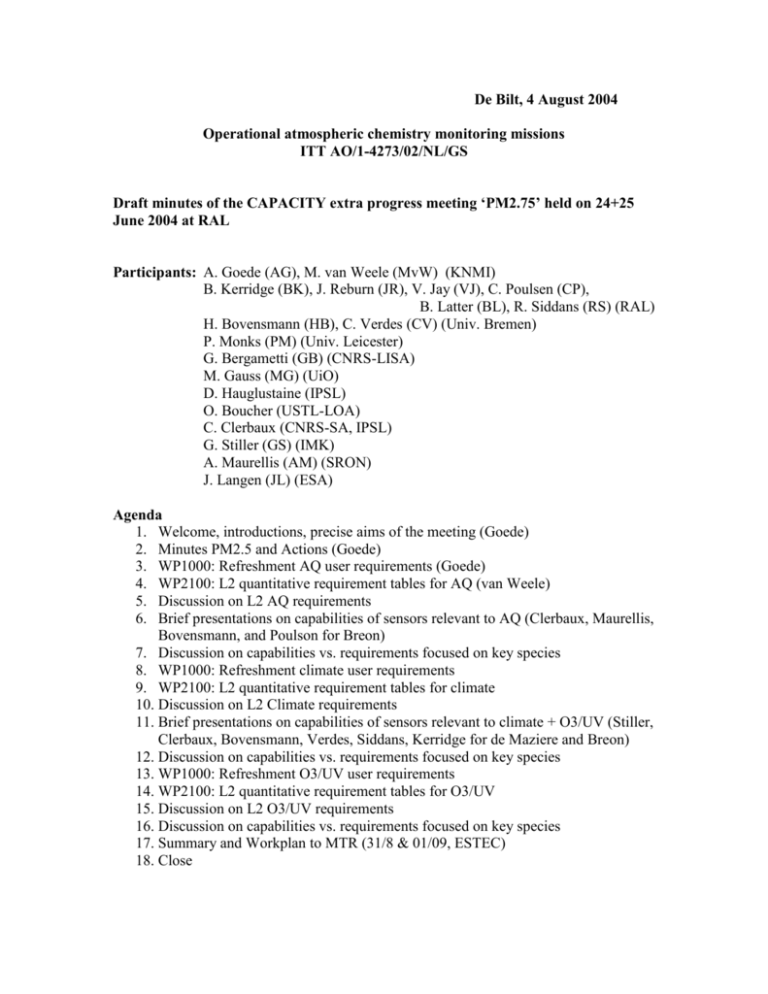
De Bilt, 4 August 2004 Operational atmospheric chemistry monitoring missions ITT AO/1-4273/02/NL/GS Draft minutes of the CAPACITY extra progress meeting ‘PM2.75’ held on 24+25 June 2004 at RAL Participants: A. Goede (AG), M. van Weele (MvW) (KNMI) B. Kerridge (BK), J. Reburn (JR), V. Jay (VJ), C. Poulsen (CP), B. Latter (BL), R. Siddans (RS) (RAL) H. Bovensmann (HB), C. Verdes (CV) (Univ. Bremen) P. Monks (PM) (Univ. Leicester) G. Bergametti (GB) (CNRS-LISA) M. Gauss (MG) (UiO) D. Hauglustaine (IPSL) O. Boucher (USTL-LOA) C. Clerbaux (CNRS-SA, IPSL) G. Stiller (GS) (IMK) A. Maurellis (AM) (SRON) J. Langen (JL) (ESA) Agenda 1. Welcome, introductions, precise aims of the meeting (Goede) 2. Minutes PM2.5 and Actions (Goede) 3. WP1000: Refreshment AQ user requirements (Goede) 4. WP2100: L2 quantitative requirement tables for AQ (van Weele) 5. Discussion on L2 AQ requirements 6. Brief presentations on capabilities of sensors relevant to AQ (Clerbaux, Maurellis, Bovensmann, and Poulson for Breon) 7. Discussion on capabilities vs. requirements focused on key species 8. WP1000: Refreshment climate user requirements 9. WP2100: L2 quantitative requirement tables for climate 10. Discussion on L2 Climate requirements 11. Brief presentations on capabilities of sensors relevant to climate + O3/UV (Stiller, Clerbaux, Bovensmann, Verdes, Siddans, Kerridge for de Maziere and Breon) 12. Discussion on capabilities vs. requirements focused on key species 13. WP1000: Refreshment O3/UV user requirements 14. WP2100: L2 quantitative requirement tables for O3/UV 15. Discussion on L2 O3/UV requirements 16. Discussion on capabilities vs. requirements focused on key species 17. Summary and Workplan to MTR (31/8 & 01/09, ESTEC) 18. Close 1. Welcome, Introductions and Precise Aims of the Meeting The meeting started at 3:00pm because of air travel delays. BK (local organiser) and AG (chair, representing Hennie Kelder) welcomed all participants and especially again the project consultants whose active involvement is considered a crucial aspect of the project. Their continued contributions and comments are highly appreciated by the project partners. AG shortly summarised the difficulties with regard to the top-down study approach as encountered at PM2.5. Major uncertainties arise from (i) the translation of high-level user requirements to (assimilated )level-4 data requirements, and (ii) the subsequent derivation of level 2 data requirements for the satellite and ground network components. JL recommended maintaining the top-down approach, but also suggested to perform some short-cuts. MvW noted that WP1000 (partly), WP2100 and WP2200 are planned in parallel. The limited time available to the study does not allow to perform tasks sequentially. BK suggested it might be most efficient at this meeting to start each of the application areas with the ”scientific understanding”, since this was the aspect in which most project partners had experience, before moving on to the “protocol/convention monitoring” and “forecasting” elements. In reaction, JL stressed again the importance of the operational services, with science as an additional driver. 2. Minutes PM2.5 and Actions The minutes of PM2.5 were reviewed and approved. AG and PM gave feedback of the telecon on user requirements for Health with a specialist from the Univ. of Leicester (cardo-vascular diseases, tropospheric ozone). The information will be added to the WP1000 report. A new date needs to be assigned to the action ‘to distribute the user requirements document WP1000 to all consultants in preparation of the MTR’ (See below, action PM2.75-1). The approved minutes of PM2.5 will be made available at the CAPACITY website, together with these draft minutes of PM2.75. 3. WP1000: Refreshment AQ user requirements (Goede) The item was skipped in view of the limited time available and the focus on WP2000. 4. WP2100: L2 quantitative requirement tables for AQ MvW presented the updated data requirements for AQ and the strategy applied to WP2100 in response to the questions posed at PM2.5. By separation of the complementary roles of, respectively satelliteborne observations, ground networks and atmospheric models it was found possible to define level-2 data requirements for the satellite component and ground networks based on the (high-level to level-4) user requirements. However, it is clear that expert judgements form the basis of the derived L2 data requirements. It was also found that a major limiting factor for WP2100 is that the uncertainty in the given quantitative data requirements increases together with the level of detail provided (more and more judgements needed). GB presented another approach to the derivation of AQ user and data requirements. In GB’s view, the models for air quality forecast meet almost all user requirements, albeit with large uncertainties. The role of dedicated satellite data should be mainly to reduce the uncertainties on the initial and boundary conditions and on the (monthly) emissions. A table with Level-2 data requirements to dedicated satellite observations, which would help to reduce these uncertainties, was presented. For example, according to GB, and given the assigned role of satellite data for AQ forecasting, the requirements on vertical resolution have lower priority than those on horizontal and temporal resolution. MvW will incorporate the presented views in the AQ part of the WP2100 report (Action PM2.75-3) 5. Discussion on L2 AQ requirements The need for sampling requirements was addressed by the statement that (near-) contiguous sampling is typically preferred, although data gaps can typically be allowed for, the extent of which depends on, e.g., time, location, and application. For the first time the need for auxilary information (i.e. not atmospheric composition) was addressed. Although most auxilary information can be obtained from the assimilated analysis fields of operational numerical weather prediction models, in some cases there may be separate measurement requirements as well. These requirements will be further worked out in the WP2100 report. All were asked to send their detailed comments to MvW (Actions PM2.75-2 and 3). 6. Brief presentations on capabilities of sensors relevant to AQ (Clerbaux, Maurellis, Bovensmann, and Poulson for Breon) CC presented the capabilities on nadir mid-IR sensors. An overview of existing and planned instruments was given. Important aspects included the possible synergy with UV-VIS nadir instruments and with meteorological sensors in general, the combination of daytime and nighttime measurements, and the pros and cons of a geostationary orbit. This agenda item was continued at Day-2 AM presented the capabilities of SCIA in nadir near-IR. Important aspects include the sensitivity to surface albedo over land and the low albedo over sea. Because vibrationrotation lines detected in the near-IR are sensitive to temperature, requirements on the temperature profile are stringent. PM reported, on behalf of John Remedios, the possibility to use a combination of day and night measurements of MOPITT in order to discriminate CO in different layers of the troposphere. HB presented the capabilities on nadir UV-VIS sensors. An overview of existing and planned instruments was given together with methods to distinguish between the troposphere and stratosphere. The impact of improved horizontal resolution on tropospheric NO2 was shown. The contributing factors to the error budget for tropospheric products were presented. CP presented on behalf of F.-M. Breon the capabilities of aerosol sensors. A short historical overview of satellite sensors was given. Dedicated sensors are quite recent. From a retrieval point of view land/ocean differences, polarisation measurements, multiple views, and the possible contribution of different spectral regions are important factors. In general, aerosol optical depth is the key parameter. Concerning aerosol speciation, it was noted that size and type typically go together. PM concentration may be obtained from an empirical relation with optical depth as derived from ground-based observations. Key challenges are aerosol absorption, aerosol vertical distribution and measurement of the indirect effect. Assimilation of radiances for mass and number (within GEMS) was identified as an important future development. The capabilities of the aerosol ground network AERONET were also presented. 7. Discussion on capabilities vs. requirements focused on key species The item was skipped in view of the limited time available. 8. WP1000: Refreshment climate user requirements The item was skipped in view of the limited time available and the focus on WP2000. 9. WP2100: L2 quantitative requirement tables for climate MvW presented the updated data requirements for climate and, similar as for AQ. The separation of the complementary roles of, respectively satelliteborne observations, ground networks and atmospheric models led to the definition of level-2 data requirements for the satellite component, ground networks and auxilary data, respectively. 10. Discussion on L2 AQ requirements The discussion was limited to a few clarifying questions to the derived data requirements. All were asked to send their detailed comments to MvW (action PM2.75-2). 11. Brief presentations on capabilities of sensors relevant to climate + O3/UV (Stiller, Clerbaux, Bovensmann, Verdes, Siddans, Kerridge for de Maziere and Breon) BK presented the capabilities of spaceborne sensors for CO2 on behalf on F.-M. Breon. Regional biases probably need to be limited to ~0.1 ppm for the column-averaged mixing ratio. Currently a threshold uncertainty requirement of 0.5% on the column is given in the level-2 data requirement tables. HB presented most recent U.Bremen results from SCIA on CO2 columns. GS presented the capabilities of limb mid-IR sensors to climate and O3/UV. In general, the requirements are considered rather stringent. On the other hand, assimilation studies show that the sampling characteristics of a limb sounder such as MIPAS can, to a certain extent, be adequately used to provide global assimilated fields of temperature and trace gases e.g. ECMWF assimilation of O3 profiles. Further presentations were by CC and HB, who presented the capabilities of solar occultation and limb UV/VIS/NIR sensors, respectively; CV who presented the capabilities of limb-(sub)mm sensors (Smiles, Odin/SMR); and RS who presented the capabilities of nadir UV-VIS sensors on ozone profiles, as well as the exploitation of limb/nadir synergy for O3 profiles, as demonstrated with MIPAS and GOME/SCIA-nadir. 12. Discussion on capabilities vs. requirements focused on key species The item was skipped in view of the limited time available. 13. WP1000: Refreshment O3/UV user requirements The item was skipped in view of the limited time available and the focus on WP2000. 14. WP2100: L2 quantitative requirement tables for O3/UV MvW presented the updated data requirements for O3/UV and, similar as for AQ and climate, a separation of the complementary roles of, respectively satelliteborne observations, ground networks and atmospheric models led to the definition of level-2 data requirements for the satellite component, ground networks and auxilary data. 15. Discussion on L2 O3/UV requirements In the discussion some elements were identified which need better definition in the available set of data requirements: - Should we add NO, NO2 at higher altitudes to the requirements to include solar cycle effects on stratospheric NOx? (action PM2.75-3) - What is the specific set of atmospheric composition requirements for NWP improvement? Do we need all tracers or only one, and can wind observations be an alternative to the tracers? (Action PM2.75-4) - Can some stratospheric requirements on long-lived compounds be relaxed and should some requirements on, e.g., ClO and BrO, be more stringent? (action PM2.75-3) All were asked to send their detailed comments to MvW (action PM2.75-2). 16. Discussion on capabilities vs. requirements focused on key species At this stage the scientific presentations were completed by BK, who presented, on behalf of Martine de Maziere, the capabilities of surface networks. These networks include NDSC networks (FTIR, DOAS, Lidar, O3-sonde, microwave), in-situ networks (ALE/GAGE/AGAGE and CMDL), the European EMEP on Air Quality as well as operational ship/aircraft measurements. Spatial sampling was shortly addressed, as well as several important issues of more general nature related to surface networks (network organisation, data availability, etc.) 17. Summary and Workplan to MTR (31/8 & 01/09, ESTEC) JR presented an overview of tasks within WP2200 together with a time schedule towards MTR. He asked for a postponement by a couple of weeks because, with vacation period approaching, time available for progress on WP2200 ahead of MTR would be limited in practice. This option turned out not to be practical. For the MTR it was decided to have a two-day meeting with on the first day feedback from the users on the user and data requirements (WP1000 and WP2100 reports), and on the second day a progress meeting, discussing the feedback received on the first day, assessing progress on WP2200 and WP2300 and have the kick-off of WP3000. Actions PM2.75-5 and PM2.75-6. 18. Close The meeting was closed at 5:15pm Actions PM2.75 Action PM2.75-1. AG to distribute the latest version of WP1000 to all partners, including consultants to prepare for MTR (31 Aug+ 1 Sep 2004) by 6 August 2004. Action PM2.75-2. All to send detailed comments on data requirements to MvW. As soon as possible, but at least before 30 July 2004. Action PM2.75-3. MvW to include comments received at the meeting and afterwards in the WP2100 report and to distribute the latest version of WP2100 to all partners including consultants to prepare for MTR (31 Aug+ 1 Sep 2004) by 6 August 2004. Action PM2.75-4. MvW to summarise the requirements on atmospheric composition for NWP improvement (in WP2100 report, due 6 Aug 2004). Action PM2.75-5. BK to distribute a first draft with results of WP2200 before 24 Aug 2004 (one week in advance of MTR). Action PM2.75-6. PM to distribute a first draft with results of WP2300 before 24 Aug 2004 (one week in advance of MTR). Action PM2.75-7. MvW to put presentations and draft minutes of this meeting at the CAPACITY website (as soon as possible).

